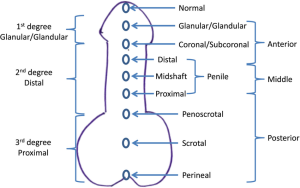Table of Contents
ToggleKey Takeaways:
- Hypospadias is a congenital condition affecting the male reproductive system.
- It occurs when the urethral opening is on the underside of the penis instead of the tip.
- Causes of hypospadias include genetic and environmental factors.
- Symptoms vary in severity and may include misplacement of the urethral opening, curved penis, and difficulty with urination.
- Diagnosis involves physical examination and additional tests to evaluate the urinary system.
- Early diagnosis is important to prevent complications.
- Treatment is done through surgery, with the approach depending on severity and location of hypospadias.
- Postoperative care is crucial for successful repair.
- Choosing a qualified surgeon specializing in pediatric urology is important for optimal outcomes.
- Researching a surgeon’s experience, success rates, and patient reviews is recommended.
- Online forums and support groups provide valuable insights and support for individuals and families.
Understanding Hypospadias: Causes and Symptoms
Hypospadias is a congenital condition that affects the male reproductive system, specifically the urethra and penis. It is estimated to occur in about 1 in every 200 live male births, making it one of the most common birth defects in boys. Hypospadias occurs when the urethral opening is located on the underside of the penis instead of the tip. This abnormal positioning can vary in severity, with mild cases having the opening just slightly off-center, and severe cases where the opening is near the scrotum or even within the scrotum itself.
The exact cause of hypospadias is not fully understood, but it is believed to be a combination of genetic and environmental factors. Research has shown that there is a higher risk of hypospadias in boys whose relatives have also been affected by the condition. Additionally, exposure to certain environmental factors during fetal development, such as hormonal imbalances or exposure to endocrine-disrupting chemicals, may increase the risk of hypospadias.
Recognizing the symptoms of hypospadias is important for early diagnosis and treatment. In mild cases, the only visible symptom may be the misplacement of the urethral opening on the underside of the penis. In more severe cases, the penis may be curved downward, the foreskin may not fully develop or cover the head of the penis, and there may be difficulty with urination or spraying of urine.
Diagnosis and Evaluation: Unraveling the Complexity
Diagnosing hypospadias typically involves a physical examination of the genital area by a healthcare professional. The severity of the condition will be assessed, and additional tests may be ordered to evaluate the structure and function of the urinary system.
One common diagnostic procedure is a uroflowmetry test, which measures the flow rate and volume of urine during urination. This can help determine if there are any abnormalities in the urinary system. Additionally, a urethrogram may be performed, where a contrast dye is injected into the urethra and X-rays are taken to visualize the urethral stricture.
Imaging techniques such as ultrasound or magnetic resonance imaging (MRI) may also be used to get a detailed view of the urinary tract and identify any associated abnormalities.
Early diagnosis of hypospadias is crucial for a successful treatment outcome. It allows for timely intervention and prevents potential complications, such as urinary tract infections and difficulties with sexual function later in life.
Treatment Options: Restoring Normal Function and Aesthetics
Hypospadias repair is typically done through surgery, with the goal of restoring normal function and aesthetics to the penis. The specific surgical approach will depend on the severity and location of the hypospadias.
In mild cases, where the urethral opening is close to the tip of the penis, a one-stage repair can often be performed. This involves creating a new urethral opening and repairing any associated deformities in a single operation.
For more severe cases, especially those where the urethral opening is closer to the scrotum or within the scrotum, a two-stage repair may be necessary. In this approach, the surgery is divided into two stages to allow for sufficient tissue growth and ensure adequate blood supply to the repaired area.
Postoperative care and recovery play a crucial role in the success of hypospadias repair. After surgery, a catheter may be placed in the urethra to help with urination and prevent complications. Antibiotics may also be prescribed to prevent infection. It is important to follow the surgeon’s instructions for wound care and hygiene to ensure proper healing.
Advances in minimally invasive techniques, such as the use of endoscopic instruments and robotic-assisted surgery, have allowed for more precise and less invasive hypospadias repair. These techniques offer the benefits of smaller incisions, reduced scarring, and faster recovery times.
Choosing the Right Surgeon: Expertise and Experience Matter
When it comes to hypospadias repair, choosing the right surgeon is crucial for the best possible outcome. It is important to research and find a qualified surgeon who specializes in pediatric urology and has extensive experience in performing hypospadias repair surgeries.
When researching qualified surgeons, consider factors such as their education, training, and board certifications. Look for surgeons who are affiliated with reputable medical institutions and have a track record of successful outcomes. Reading patient reviews and testimonials can also provide valuable insights into a surgeon’s expertise and patient satisfaction.
Before scheduling a consultation with a surgeon, prepare a list of questions to ask. Inquire about their experience with hypospadias repair, their success rates, and any potential complications or risks associated with the procedure. It is also important to discuss the expected outcomes and realistic expectations for the surgery.
It can be reassuring to hear stories of successful hypospadias repair from other patients and their families. Many online forums and support groups provide a platform for sharing experiences and connecting with others who have gone through similar journeys. Hearing about successful outcomes can provide hope and confidence for those facing hypospadias repair.
In conclusion, hypospadias is a common congenital condition that affects the male reproductive system. Understanding the causes and symptoms of hypospadias is crucial for early diagnosis and treatment. Surgical repair is usually necessary to restore normal function and aesthetics to the penis. Choosing a qualified surgeon with expertise and experience in hypospadias repair is paramount for achieving a successful outcome. By delving deep into the complexities of hypospadias and exploring the available treatment options, individuals and families affected by this condition can make informed decisions and restore confidence in their future.
FAQ
Question: What is hypospadias? – Hypospadias is a congenital condition that affects the male reproductive system, specifically the urethra and penis. It occurs when the urethral opening is on the underside of the penis instead of the tip.
Question: What causes hypospadias? – The exact cause of hypospadias is not fully understood, but it is believed to be a combination of genetic and environmental factors. Research has shown that there is a higher risk of hypospadias in boys whose relatives have also been affected by the condition. Additionally, exposure to certain environmental factors during fetal development may increase the risk.
Question: What are the symptoms of hypospadias? – Symptoms of hypospadias vary in severity. In mild cases, the only visible symptom may be the misplacement of the urethral opening. In more severe cases, the penis may be curved downward, the foreskin may not fully develop or cover the head of the penis, and there may be difficulty with urination or spraying of urine.
Question: How is hypospadias diagnosed? – Hypospadias is typically diagnosed through a physical examination of the genital area by a healthcare professional. Additional tests, such as uroflowmetry, urethrogram, or imaging techniques like ultrasound or MRI, may be done to evaluate the structure and function of the urinary system.
Question: What are the treatment options for hypospadias? – Hypospadias repair is usually done through surgery, with the approach depending on the severity and location of the condition. For mild cases, a one-stage repair may be performed. More severe cases may require a two-stage repair. Postoperative care and recovery are crucial for successful repair.
Question: How do I choose the right surgeon for hypospadias repair? – When choosing a surgeon for hypospadias repair, it is important to consider their expertise and experience in pediatric urology. Research their education, training, board certifications, and success rates. Reading patient reviews and testimonials can also provide valuable insights.
Question: Are there any support groups or forums for individuals and families affected by hypospadias? – Yes, there are online forums and support groups available that provide a platform for sharing experiences and connecting with others who have gone through similar journeys. These can provide valuable insights and support for individuals and families facing hypospadias repair.
Question: What is the importance of early diagnosis in hypospadias? – Early diagnosis of hypospadias is crucial for timely intervention and preventing potential complications. It allows for the implementation of appropriate treatment and management strategies to ensure optimal outcomes and prevent long-term issues such as urinary tract infections and difficulties with sexual function.







